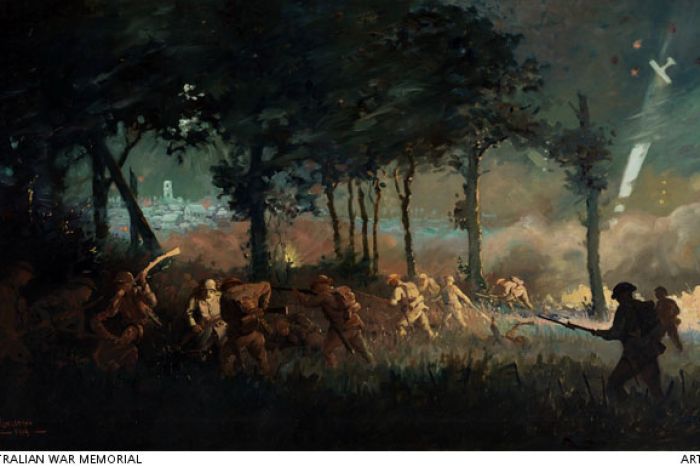
Villers-Bretonneux still remembers Australia
The battle of Villers-Bretonneux in France, and the subsequent pushing back of German forces, has been described as a crucial turning point in World War I. Among other allied foreces, two Australian brigades took part in the counter-attack to stop the German spring offensive on the night of April 24 in 1918, along with three British battalions.
A part of Australia's history
Australian troops displayed great bravery, but also suffered a terrible loss. Some 2,400 Australians died in the battle to recapture the town, according to the Department of Veterans' Affairs. Peter Pedersen, consultant historian to the Australian Federal Government's WWI centenary, says that while Australians rightly commemorate the fighting at Gallipoli, the battles at Villers-Bretonneaux should be given higher prominence in accounts of Australia's involvement in WWI.
"That was the main theatre – the only place the war could be won was the Western Front," he told the ABC.
"The Anzacs played a central role in the winning of that war.
"The Australians' role on the Western Front deserves to be better known."
The town of Amiens
In March 1918, the Germans launched a major offensive attack to take the strategic French town of Amiens. As they moved westwards towards their goal, at dawn on April 24 they captured the tactically important town of Villers-Bretonneux, after a previous attempt on April 4-5. The town, which lies just south of the River Somme, opened the way to Amiens.
An immediate counter-attack was planned by British commanders, with two Australian brigades and three British battalions ordered to encircle the town at night. Dr Pedersen says the Australians had "by far" the most important role in the battle. The manoeuvre involved the Australian brigades approaching the town from opposing directions in order to trap the Germans.
The 13th Brigade of the 4th Australian Division, commanded by General William Glasgow, would attack to the south of Villers-Bretonneux, while the 15th Brigade of the 5th Australian Division, commanded by General Harold "Pompey" Elliot, would attack to the north. In all, about 3,900 men were part of the attack.
Australians advance in the night
The surprise attack happened at night. The plan was to encircle and trap the Germans - in the dark and without support. Historian Ross McMullin, who wrote a biography on General Elliot, says he wanted to attack right away after the Germans captured the town. The 15th Brigade had already been stationed near Villers-Bretonneux by April 23.
"Pompey Elliott wanted to counter-attack immediately, but did not receive the green light until hours later, when the Germans had consolidated their positions in the town," he said. "The fact that it was now night-time also made Elliot's plan, a complex envelopment manoeuvre, more difficult to implement." Dr Pedersen says the odds against the Australian-led counter-attack succeeding were very high.
Australian official war correspondent Charles Bean, who was nearby when the attack happened, wrote in his diary: "I don't believe they have a chance". "Went to bed thoroughly depressed ... feeling certain that this hurried attack would fail hopelessly," he wrote. However Mr McMullin, who is currently in Ypres in Belgium for WWI commemorations, says the men had a good reason to counter-attack "resolutely". "[They were] aware it was the third anniversary of the original Anzac Day and they had an opportunity to commemorate it with a special exploit," he said. "They overcame the Germans north of the town in a famously irresistible charge."
Dr Pedersen says the fact the Australians worked without reconnaissance to retake the town is a testament to their skill. "At the time it earned the praise of the British who saw it," he said. One journalist, he said, called it one of the most outstanding manoeuvres of the war. By the dawn of April 25, three years after the initial landing at Gallipoli, the Australians had broken through the German entrenchment. It took the rest of the day and into the next to secure Villers-Bretonneux and create a new front line to the east, ending the German offensive on the Somme. Those Germans who were not captured or killed were then pushed back towards the woods adjacent to Villers-Bretonneux.
Survival of Villers-Bretonneux
The town did not fall into enemy hands for the rest of WWI. While hundreds of lives were lost in the battle, the people of Villers-Bretonneux have not forgotten the Australian sacrifice. The Australian flag continues to fly over the town. Recognition of the significance of the battle can be found at the Australian National Memorial, built just outside the town. It was approved by the Australian Government after WWI, to commemorate the sacrifice of the Australian Imperial Forces on the Western Front.
Unveiled in July 1938 by Queen Elizabeth, the memorial contains the names of the 11,000 Australians missing in action in France. Each year on Anzac Day, a small ceremony is held at the memorial to mark the sacrifice of the diggers. In recent years, a dawn service has also been held.
Donation to Villers-Bretonneux School
After WWI money donated by school children in Victoria, Australia, was used to build a new school in Villers-Bretonneux, named the Victoria school. A plaque at the school says it is "proof of their love and goodwill towards France". And in the Victoria School's playground and above the blackboards is written: "Do not forget Australia".
A reciprocal action
After the 'Black Saturday' bushfires caused massive devastation in Victoria on 7 February 2009, the children of the Villers-Bretonneux 'Victoria School' started collecting money to donate much needed funding to rebuild one of the schools destroyed in the fires. A lifetime bond between France and Australia has been one of the most valuable outcomes of two devastating ocurrences.
Check out our hand-picked Battlefields tours